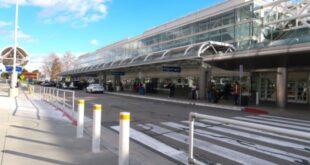A celebration was held Nov. 1 exactly five years to the day that Ontario International broke away from Los Angeles and was taken over by a joint partnership between San Bernardino County and Ontario. The airport’s record since then has been an overwhelming success, even with COVID-19.
Ontario International Airport took a victory lap last week.
About 350 people gathered at the Ontario Convention Center Nov. 1, five years to the day that the airport was turned over to local ownership: away from the city of Los Angeles and into the hands of a joint powers authority made up of San Bernardino County and the city of Ontario.
The gathering of city and regional leaders, aviation executives, airline personnel and other supporters of Ontario International was a celebration of the “remarkable journey” the airport underwent to break away from Los Angeles World Airports, its previous owner.
Better known as LAWA, that agency owned and operated Ontario International from 1985 to the first day of November 2016.
That transfer came after a seven-year battle in which Inland Empire officials accused LAWA of letting Ontario International decline for the sake of Los Angeles International, the largest and most lucrative of the agency’s aviation properties.
“It was LAWA’s greed that almost destroyed the airport,” Inland Empire economist John Husing said. “They cut back at Ontario International so they could pay for the expansion at Los Angeles International.”
Husing was a staunch advocate of getting Ontario International away from LAWA. In 2013, while delivering his annual assessment of the Inland Empire economy, Husing declared that the agency should “burn in hell” for allowing the airport to lose 40 percent of its traffic count between 2007 and 2012, after reaching a peak of 7.2 million passengers in 2005.
Today, Husing could not be more pleased with the airport, which he called “an absolutely vital part” of the Inland economy.
“When LAWA was operating it they shrunk the number of flights and they didn’t market the property,” Husing said. “People here had to drive to LAX to get a flight anywhere, which was ridiculous.
“Now we have a first-rate airport, which is as crucial to the Inland Empire’s economy as the ports in Los Angeles and Long Beach.”
Since the changeover, Ontario International has added flights – including international flights to Mexico and El Salvador – increased its passenger and cargo counts and made major upgrades to its two terminals.
Much of that happened during the worst of COVID-19.
“We knew on that fateful day five years ago that the combination of first-rate facilities, operations know-how and broad local support positioned us well to develop Ontario International into a premier aviation gateway and deliver the air service and amenities that air travelers demand,” said Alan D. Wapner, Ontario’s Mayor pro tem and president of the Ontario International Airport Authority’s board of commissioners, in a statement.
“We’ve transformed Ontario International from an airport that had been forgotten or disregarded into a thriving low-cost, international gateway for airlines, air passengers and freight shippers.”
Since taking control of the airport, the airport authority has increased the number of airlines by nearly 50 percent and nearly doubled its nonstop destinations. Also during the authority’s tenure, weekly flight departures have gone from 403 to 460 while passenger seats increased from 52,000 to 66,500.
In 2019, more than 5.5 million passengers passed through Ontario International, its highest passenger count in 10 years. For the second consecutive year, it was named the fastest growing airport in the United States by Global Traveler, a trade publication geared to business and leisure travelers.
Also that year, the airport authority spent more than $8 million upgrading the Ontario International’s restaurants and retail concessions.
The pandemic took a major bite out of Ontario International’s passenger count, which was down 90 percent year-over-year in March 2020, when COVID-19 hit the United States. Passenger traffic was down to 50 percent by the end of last year, but since then it has picked up, getting to 97 percent of its pre-pandemic levels in September
In September, air freight and mail shipments totaled more than 70,000 tons, 9.4 percent lower than September 2020 but 15.4 percent higher than September 2019, according to the airport authority.
Cargo volume was more than 644,000 tons during the first nine months of this year, a 3.5 percent decline from 2020, but 15.6 percent higher than the first nine months of 2019, the authority reported.
This year will likely be Ontario International’s second-best year ever for cargo shipments, second only to 2020 when shipments increased 20 percent thanks to a boom in online shopping brought on by the pandemic.
Everyone who argued that Ontario International would be better off under local control has been proven right, said Paul Granillo, president and chief executive officer of the Inland Empire Economic Partnership, the region’s largest economic development organization.
“Everything that’s happened at Ontario International in the last five years has been tremendous,” said Granillo, whose organization is tasked with attracting business to Riverside and San Bernardino counties. “The pandemic slowed things down, but people can travel in and out of the Inland Empire now, and the hotels and businesses are doing a lot better.
“Ontario International is our connection to the rest of the world.”
The inside of Ontario International deteriorated badly during the last few years of LAWA’s stewardship, according to Granilllo.
“I remember going into the terminals and there was nothing open,” Granillo said. “You couldn’t get a drink, or anything to eat. It was embarrassing. Those places were under contract to stay open for a certain set of hours , but LAWA wasn’t enforcing it. But all of that has turned around.”
The negotiations to get control of the airport were often difficult, but LAWA eventually realized it was in its best interest to go along with Ontario’s plan for local control, said Frank Williams, former president of the Ontario Airport Alliance, a now-defunct organization of Inland business owners that advocated for the takeover.
“LAWA got to where it saw the writing on the wall,” said Williams, who is retired and living in St. Augustine, Fla. “They wanted to unload it, but they were acting like they didn’t want to unload it. But the business community was able put pressure on them, and the politicians were able to get a deal done.”
Williams passed through Ontario International last month and liked what he saw.
“It felt good,” he said. “Things were open and you could tell a difference. It was a very lively airport.”
Ontario International will improve more if a planned underground tunnel project between the airport and the Rancho Cucamonga Metrolink Station happens, according to Granillo.
The 2.8-mile high-speed project would be developed by Elon Musk’s The Boring Cos. and the San Bernardino County Transportation Authority.
“I think you’ll see that and another terminal at some point,” Granillo said. “That’s the kind of out-of-the-box thinking we never got from LAWA.”
 IE Business Daily Business news for the Inland Empire.
IE Business Daily Business news for the Inland Empire.


